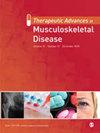Costotransverse joint ankylosis and their association with syndesmophyte progression in patients with radiographic axial spondyloarthritis
IF 3.4
2区 医学
Q2 RHEUMATOLOGY
引用次数: 0
Abstract
Background:Abnormal new bone formation can occur not only in the vertebral body but also can occur in facet, costovertebral, and costotransverse joints in radiographic axial spondyloarthritis (r-axSpA) patients. Little is known about the association between syndesmophyte progression and paravertebral joint ankylosis in r-axSpA.Objectives:Costotransverse joint ankylosis in r-axSpA patients was measured. Furthermore, the association between syndesmophyte progression for 2 years assessed by computed tomography syndesmophyte score (CTSS) and facet, costovertebral, and costotransverse joints ankylosis were evaluated.Design:Single-center, prospective, cohort study.Methods:Whole spine CT images taken at baseline and 2-year follow-up were used to calculate the CTSS of the vertebral body. In addition, ankylosis of the facet/costovertebral/costotransverse joints was scored. CTSS (range, 0–552) and facet joint ankylosis (range, 0–46) were assessed at 23 vertebral units. Costovertebral joints at T1–T12 (range, 0–48) and costotransverse joints at T1–T10 (range, 0–20) were also assessed by independent two readers. Intraclass correlation coefficients (ICC) were calculated to determine inter-reader reliability. Odds ratios (OR) were calculated to identify the associations between syndesmophyte progression and the baseline status of facet, costovertebral, and costotransverse joints.Results:In all, 50 patients with r-axSpA were included. Readers 1 and 2 identified C7–T3 (facet joints), T5–T7 and T12 (costovertebral joints), and T8–T9 (costotransverse joints), as common sites of ankylosis at baseline and at 2-year follow-up. The ICCs for the facet, costovertebral, and costotransverse joints at baseline were 0.876, 0.952, and 0.753, respectively. OR of baseline costovertebral and costotransverse joint ankylosis for predicting syndesmophyte progression of the vertebral body was 4.644 [95% confidence interval (CI), 2.295–9.398] and 1.524 (95% CI, 1.036–2.244), respectively.Conclusion:Costotransverse joint ankylosis in r-axSpA patients can be measured semi-quantitatively on whole spine CT, and ankylosis of the costotransverse and costovertebral joints predicts the progression of syndesmophytes. Trial registration: Not applicable.放射性轴性脊柱关节炎患者的肋横关节强直及其与联合骨质增生进展的关系
背景:异常的新骨形成不仅可能发生在椎体,也可能发生在放射学轴性脊柱关节炎(r-axSpA)患者的面关节、椎旁关节和椎横关节。人们对r-axSpA患者的联合骨赘进展与椎旁关节强直之间的关系知之甚少。设计:单中心、前瞻性、队列研究。方法:使用基线和两年随访时拍摄的全脊柱 CT 图像计算椎体 CTSS。此外,还对椎面关节/椎间关节/椎横突关节的强直情况进行了评分。对23个椎体单位的CTSS(范围0-552)和面关节强直(范围0-46)进行了评估。T1-T12椎体上的肋间关节(范围:0-48)和T1-T10椎体上的肋横关节(范围:0-20)也由独立的两名读者进行评估。计算类内相关系数 (ICC) 以确定阅读者之间的可靠性。计算了比值比(OR),以确定联合骨质增生进展与面骨关节、椎板上关节和椎板下关节基线状态之间的关联。读者1和读者2发现C7-T3(面关节)、T5-T7和T12(椎旁关节)以及T8-T9(椎旁关节)是基线和2年随访时常见的强直部位。基线时,面关节、椎体外成本关节和椎体外成本关节的 ICC 分别为 0.876、0.952 和 0.753。基线椎间和椎横联合强直的OR值分别为4.644[95%置信区间(CI),2.295-9.398]和1.524(95%置信区间(CI),1.036-2.244),可预测椎体联合关节增生的进展。结论:脊柱全CT可半定量测量r-axSpA患者的肋横关节强直,肋横关节和肋椎关节强直可预测联合骨赘的进展。试验注册:不适用。
本文章由计算机程序翻译,如有差异,请以英文原文为准。
求助全文
约1分钟内获得全文
求助全文
来源期刊

Therapeutic Advances in Musculoskeletal Disease
Medicine-Rheumatology
CiteScore
6.80
自引率
4.80%
发文量
132
审稿时长
18 weeks
期刊介绍:
Therapeutic Advances in Musculoskeletal Disease delivers the highest quality peer-reviewed articles, reviews, and scholarly comment on pioneering efforts and innovative studies across all areas of musculoskeletal disease.
 求助内容:
求助内容: 应助结果提醒方式:
应助结果提醒方式:


